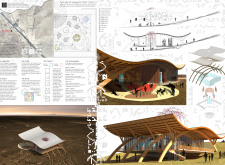5 key facts about this project
The pavilion is structured around three primary areas: a performance area for cultural events, exhibition galleries for showcasing artifacts, and flexible workshop spaces for immersive learning experiences. Each zone is tailored to accommodate various activities, thereby promoting interaction and engagement within the community. The use of large, expansive glass surfaces facilitates visual connectivity with the surrounding environment, further enhancing the sense of openness.
Unique Design Approaches
One of the defining features of this project is its undulating roof structure, which not only provides aesthetic appeal but also offers practicality in the form of shade and protection from harsh weather conditions. This dynamic roofing approach signifies a departure from traditional linear designs, creating an organic flow that resonates with visitors. Additionally, the integration of green roofs or living walls, if incorporated, supports sustainability and biodiversity, aligning with contemporary environmental priorities.
Another notable aspect of the pavilion is the thoughtful selection of materials. The use of structural timber allows for a lightweight yet robust construction, paired with concrete foundations that ensure stability. The extensive glass facades contribute to passive energy efficiency by maximizing natural illumination while maintaining a connection to the external landscape.
Architectural Details
The spatial layout of the Pavilion of Humanity facilitates a variety of functions designed to encourage social interaction. The central performance area acts as a focal point for gatherings, while the exhibition galleries serve as educational spaces that promote cultural understanding. Workshop areas are strategically located to allow for collaboration and the exchange of ideas, providing visitors with hands-on experiences.
Attention to detail is evident in the design elements, including the seamless integration of indoor and outdoor spaces. The careful orchestration of sightlines encourages exploration while ensuring a cohesive experience. Each element of the pavilion, from the natural materials to the sculptural forms, works harmoniously to create an inclusive environment that prioritizes human connection.
For further insights into this architectural project, interested readers are encouraged to explore architectural plans, architectural sections, and architectural designs that provide deeper understanding of the Pavilion of Humanity's structural and conceptual framework. These resources offer valuable context and detail, allowing for a comprehensive appreciation of the architectural ideas that underpin this project.























